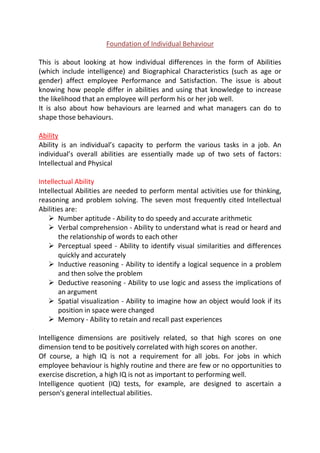
Notes individual behaviour
- 1. Foundation of Individual Behaviour This is about looking at how individual differences in the form of Abilities (which include intelligence) and Biographical Characteristics (such as age or gender) affect employee Performance and Satisfaction. The issue is about knowing how people differ in abilities and using that knowledge to increase the likelihood that an employee will perform his or her job well. It is also about how behaviours are learned and what managers can do to shape those behaviours. Ability Ability is an individual’s capacity to perform the various tasks in a job. An individual’s overall abilities are essentially made up of two sets of factors: Intellectual and Physical Intellectual Ability Intellectual Abilities are needed to perform mental activities use for thinking, reasoning and problem solving. The seven most frequently cited Intellectual Abilities are: Number aptitude - Ability to do speedy and accurate arithmetic Verbal comprehension - Ability to understand what is read or heard and the relationship of words to each other Perceptual speed - Ability to identify visual similarities and differences quickly and accurately Inductive reasoning - Ability to identify a logical sequence in a problem and then solve the problem Deductive reasoning - Ability to use logic and assess the implications of an argument Spatial visualization - Ability to imagine how an object would look if its position in space were changed Memory - Ability to retain and recall past experiences Intelligence dimensions are positively related, so that high scores on one dimension tend to be positively correlated with high scores on another. Of course, a high IQ is not a requirement for all jobs. For jobs in which employee behaviour is highly routine and there are few or no opportunities to exercise discretion, a high IQ is not as important to performing well. Intelligence quotient (IQ) tests, for example, are designed to ascertain a person's general intellectual abilities.
- 2. Physical Ability Physical Ability is the capacity to do tasks that demand stamina, dexterity, strength and similar characteristics. Though the changing nature of work suggests that Intellectual Abilities are becoming increasingly important for many jobs, Physical Abilities have been and will remain important for successfully doing certain jobs. Research on the requirements needed in hundreds of jobs has identified nine basic abilities involved in the performance of physical tasks Strength Factor Dynamic strength - Ability to exert muscular force repeatedly or continuously over Trunk strength time - Ability to exert muscular strength using the trunk (particularly abdominal) muscles Static strength - Ability to exert force against external objects Explosive strength - Ability to expend a maximum of energy in one or a series of explosive acts Flexibility Factors Extent Flexibility - Ability to move the trunk and back muscles as far as possible Dynamic Flexibility – Ability to make rapid, repeated flexing movements Other Factors Body Coordination - Ability to coordinate the simultaneous actions of different parts of the body Balance - Ability to maintain equilibrium despite forces pulling off balance Stamina – Ability to continue maximum effort requiring prolonged effort over time Individuals differ in the extent to which they have each of these abilities. Not surprisingly, there is also little relationship among them: A high score on one is no assurance of a high score on others. High employee performance is likely to be achieved when management has ascertained the extent to which a job requires each of the nine abilities and then ensures that employees in that job have those abilities.
- 3. Biographical Characteristics These are the personal characteristics, such as age, gender, date of birth, marital status and other details that are objective (Based on Facts rather than interpretations) and easily obtained from personnel records. These Characteristics have an important role to play as it has direct impact on an individual’s life and can help for example to know when the employee will quit the job due to his age.
- 4. Learning Learning may be defined as any relatively permanent change in behaviour that occurs as a result of experience All complex behaviours are learned. If we want to explain and predict behaviour, we need to understand how people learn and thus Managers can use this to facilitate employee learning. Three theories have been offered to explain the process by which we acquire patterns of behaviour. These are: Classical Conditioning, Operant Conditioning and Social Learning.